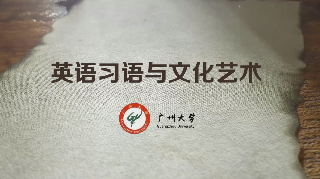广州大学
第一章单元测试
- What is idiom? ( )
- Which one of the following statements is correct? ( )
- Which of the following can best explain the meaning of “to lay heads together”? ( )
- Which of the following statement is true? ( )
- Which of the following is NOT an idiom? ( )
- What is culture? ( )
- What is non-material culture? ( )
- Why are idioms important? ( )
- Which of the following statements are true about culture? ( )
- What are true about material culture and non-material culture? ( )
A:Idiom is a group of words. B:Idiom is a group of words whose meaning is different from the meanings of the individual words. C:Idiom is an expression or word used in informal conversation. D:Idiom is a single unit of language which means something and used in formal articles.
答案:Idiom is a group of words whose meaning is different from the meanings of the individual words.
A:The structure of idioms is fixed. B:People seldom use idioms in daily conversation. C:Idioms directly express their meaning. D:Idioms follow regular rules of grammar.
答案:The structure of idioms is fixed.
A:To choose the cleverest one. B:To work together to come up with an idea or solution. C:People sit together to spread a rumor. D:People gently put their heads together one by one.
答案:To work together to come up with an idea or solution.
A:Words in an idiom can be changed by their synonyms. B:Metaphor is most frequently used in English idioms. C:Idioms do not employ figures of speech. D:Idioms can be found only in Chinese and English.
答案:Metaphor is most frequently used in English idioms.
A:as mad as a hatter B:It is raining cats and dogs. C:to be at liberty D:the same as
答案:the same as
A:Culture is everything in written form. B:Culture is the learned and shared behaviors, beliefs, attitudes, and values that characterize a particular society. C:Culture is the language people speak in each country. D:Culture is everything shared by people on earth.
答案:Culture is the learned and shared behaviors, beliefs, attitudes, and values that characterize a particular society.
A:Everything exists in our life. B:The things people created during their lives, the things that humans make and use. C:A wide variety of things, from buildings, technological gadgets, and clothing, to film, music, literature, and art. D:The values and beliefs, language, communication, and practices that are shared by a group of people.
答案:The values and beliefs, language, communication, and practices that are shared by a group of people.
A:English speakers frequently use idioms both in oral and written language. B:Idioms are the essence of a language. C:Idioms will help in your reading, writing, and translation. D:Many language test systems, such as IELTS, clearly stipulate the use of idioms at each level.
答案:English speakers frequently use idioms both in oral and written language.###Idioms are the essence of a language.###Idioms will help in your reading, writing, and translation.###Many language test systems, such as IELTS, clearly stipulate the use of idioms at each level.
A:Culture is composed of material culture and non-material culture. B:Culture is transmitted from one generation to the next. C:Culture is changing. D:Culture is shared.
答案:Culture is composed of material culture and non-material culture.###Culture is transmitted from one generation to the next.###Culture is changing.###Culture is shared.
A:Material culture emerges from non-material culture. B:Material culture and non-material culture don’t exist simultaneously. C:Material culture can also influence the non-material aspects of culture. D:Material culture is shaped by non-material culture.
答案:Material culture emerges from non-material culture.###Material culture can also influence the non-material aspects of culture.###Material culture is shaped by non-material culture.
温馨提示支付 ¥3.00 元后可查看付费内容,请先翻页预览!
